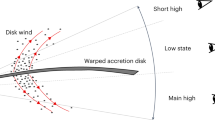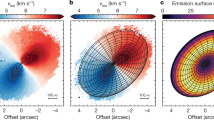Abstract
The formation of astrophysical objects of different nature, from black holes to gaseous giant planets, involves a disk–jet system, where the disk drives the mass accretion onto a central compact object and the jet is a fast collimated ejection along the disk rotation axis. Magnetohydrodynamic disk winds can provide the link between mass accretion and ejection, which is essential to ensure that the excess angular momentum is removed and accretion can proceed. However, until now, we have been lacking direct observational proof of disk winds. Here we present a direct view of the velocity field of a disk wind around a forming massive star. Achieving a very high spatial resolution of about 0.05 au, our water maser observations trace the velocities of individual streamlines emerging from the disk orbiting the forming star. We find that, at low elevation above the disk midplane, the flow co-rotates with its launch point in the disk, in agreement with magneto-centrifugal acceleration. Beyond the co-rotation point, the flow rises spiralling around the disk rotation axis along a helical magnetic field. We have performed (resistive-radiative-gravito-)magnetohydrodynamic simulations of the formation of a massive star and record the development of a magneto-centrifugally launched jet presenting many properties in agreement with our observations.
This is a preview of subscription content, access via your institution
Access options
Access Nature and 54 other Nature Portfolio journals
Get Nature+, our best-value online-access subscription
$29.99 / 30 days
cancel any time
Subscribe to this journal
Receive 12 digital issues and online access to articles
$119.00 per year
only $9.92 per issue
Buy this article
- Purchase on Springer Link
- Instant access to full article PDF
Prices may be subject to local taxes which are calculated during checkout






Similar content being viewed by others
Data availability
This article makes use of the following EVN data: GM077 (EVN project code). The calibrated datasets generated during and/or analysed during the current study are available from the corresponding author on reasonable request.
Code availability
The custom parts of the code for producing the simulations and subsequent data analysis are not ready for public use, but they can be provided upon reasonable request. For the magnetohydrodynamics part of the software, we make use of the open-source code Pluto35,41. The implementation method of the employed radiation transport module (‘Makemake’) is publicly accessible38.
References
Pudritz, R. E. & Norman, C. A. Centrifugally driven winds from contracting molecular disks. Astrophys. J. 274, 677–697 (1983).
Blandford, R. D. & Payne, D. G. Hydromagnetic flows from accretion disks and the production of radio jets. Mon. Not. R. Astron. Soc. 199, 883–903 (1982).
Ouyed, R. & Pudritz, R. E. Numerical simulations of astrophysical jets from Keplerian Disks. I. Stationary models. Astrophys. J. 482, 712–732 (1997).
Krasnopolsky, R., Li, Z.-Y. & Blandford, R. Magnetocentrifugal launching of jets from accretion disks. I. Cold axisymmetric flows. Astrophys. J. 526, 631–642 (1999).
Bacciotti, F., Ray, T. P., Mundt, R., Eislöffel, J. & Solf, J. Hubble Space Telescope/STIS spectroscopy of the optical outflow from DG Tauri: indications for rotation in the initial jet channel. Astrophys. J. 576, 222–231 (2002).
Hirota, T. et al. Disk-driven rotating bipolar outflow in Orion Source I. Nat. Astron. 1, 0146 (2017).
Lee, C.-F. et al. A rotating protostellar jet launched from the innermost disk of HH 212. Nat. Astron. 1, 0152 (2017).
Aalto, S. et al. ALMA resolves the remarkable molecular jet and rotating wind in the extremely radio-quiet galaxy NGC 1377. Astron. Astrophys. 640, A104 (2020).
Tabone, B. et al. Constraining MHD disk winds with ALMA. Apparent rotation signatures and application to HH212. Astron. Astrophys. 640, A82 (2020).
Matthews, L. D. et al. A feature movie of SiO emission 20–100 au from the massive young stellar object Orion Source I. Astrophys. J. 708, 80–92 (2010).
Moscadelli, L. & Goddi, C. A multiple system of high-mass YSOs surrounded by disks in NGC 7538 IRS1. Gas dynamics on scales of 10–700 au from CH3OH maser and NH3 thermal lines. Astron. Astrophys. 566, A150 (2014).
Sanna, A. et al. Velocity and magnetic fields within 1000 au of a massive YSO. Astron. Astrophys. 583, L3 (2015).
Moscadelli, L., Cesaroni, R., Rioja, M. J., Dodson, R. & Reid, M. J. Methanol and water masers in IRAS 20126+4104: the distance, the disk, and the jet. Astron. Astrophys. 526, A66 (2011).
Burns, R. A. et al. A ‘water spout’ maser jet in S235AB-MIR. Mon. Not. R. Astron. Soc. 453, 3163–3173 (2015).
Moscadelli, L. et al. Outflow structure within 1000 au of high-mass YSOs. I. First results from a combined study of maser and radio continuum emission. Astron. Astrophys. 585, A71 (2016).
Xu, Y. et al. On the nature of the local spiral arm of the Milky Way. Astrophys. J. 769, 15 (2013).
Moscadelli, L. et al. Multi-scale view of star formation in IRAS 21078+5211: from clump fragmentation to disk wind. Astron. Astrophys. 647, A114 (2021).
Pudritz, R. E., Ouyed, R., Fendt, C. & Brandenburg, A. in Disk Winds, Jets, and Outflows: Theoretical and Computational Foundations. Protostars and Planets V (eds Reipurth, B. et al.) 277-294 (2007), University of Arizona Press, Tucson.
Pudritz, R. E. & Ray, T. P. The role of magnetic fields in protostellar outflows and star formation. Front. Astron. Space Sci. 6, 54 (2019).
Elitzur, M., Hollenbach, D. J. & McKee, C. F. Planar H2O masers in star-forming regions. Astrophys. J. 394, 221–227 (1992).
Hollenbach, D., Elitzur, M. & McKee, C. F. Interstellar H2O masers from J shocks. Astrophys. J. 773, 70 (2013).
Kaufman, M. J. & Neufeld, D. A. Water maser emission from magnetohydrodynamic shock waves. Astrophys. J. 456, 250–+ (1996).
Pesenti, N. et al. Predicted rotation signatures in MHD disc winds and comparison to DG Tau observations. Astron. Astrophys. 416, L9–L12 (2004).
Sanna, A. et al. VLBI study of maser kinematics in high-mass star-forming regions. I. G16.59−0.05. Astron. Astrophys. 517, A71 (2010).
Reid, M. J. et al. The distance to the center of the galaxy—H2O maser proper motions in Sagittarius B2(N). Astrophys. J. 330, 809–816 (1988).
Zhang, Q., Claus, B., Watson, L. & Moran, J. Angular momentum in disk wind revealed in the young star MWC 349A. Astrophys. J. 837, 53 (2017).
Pelletier, G. & Pudritz, R. E. Hydromagnetic disk winds in young stellar objects and active galactic nuclei. Astrophys. J. 394, 117 (1992).
Staff, J., Koning, N., Ouyed, R. & Pudritz, R. Three-dimensional simulations of MHD disk winds to hundred AU scale from the protostar. Eur. Phys. J. Web Conf 64, 05006 (2014).
Caratti o Garatti, A. et al. Disk-mediated accretion burst in a high-mass young stellar object. Nat. Phys. 13, 276–279 (2017).
Hunter, T. R. et al. An extraordinary outburst in the massive protostellar system NGC 6334I−MM1: quadrupling of the millimeter continuum. Astrophys. J. Lett. 837, L29 (2017).
Oliva, G. A. & Kuiper, R. Modeling disk fragmentation and multiplicity in massive star formation. Astron. Astrophys. 644, A41 (2020).
Anglada, G., Rodríguez, L. F. & Carrasco-González, C. Radio jets from young stellar objects. Astron. Astrophys. Rev. 26, 3 (2018).
Elitzur, M., Hollenbach, D. J. & McKee, C. F. H2O masers in star-forming regions. Astrophys. J. 346, 983–990 (1989).
Moscadelli, L. et al. Protostellar Outflows at the Earliest Stages (POETS). IV. Statistical properties of the 22 GHz H2O masers. Astron. Astrophys. 635, A118 (2020).
Mignone, A. et al. PLUTO: a numerical code for computational astrophysics. Astrophys. J. Suppl. Ser. 170, 228–242 (2007).
Machida, M. N., Inutsuka, S.-i & Matsumoto, T. Magnetic fields and rotations of protostars. Astrophys. J. 670, 1198–1213 (2007).
Kuiper, R., Klahr, H., Beuther, H. & Henning, T. Circumventing the radiation pressure barrier in the formation of massive stars via disk accretion. Astrophys. J. 722, 1556–1576 (2010).
Kuiper, R., Yorke, H. W. & Mignone, A. Makemake + Sedna: a continuum radiation transport and photoionization framework for astrophysical newtonian fluid dynamics. Astrophys. J. Suppl. Ser. 250, 13 (2020).
Mouschovias, T. C. & Spitzer, J. L. Note on the collapse of magnetic interstellar clouds. Astrophys. J. 210, 326 (1976).
Kölligan, A. & Kuiper, R. Jets and outflows of massive protostars. From cloud collapse to jet launching and cloud dispersal. Astron. Astrophys. 620, A182 (2018).
Mignone, A. et al. PLUTO: a code for flows in multiple spatial dimensions. Astrophysics Source Code Library ascl:1010.045 (2010).
Acknowledgements
We thank C. Fendt and D. Galli for useful discussion. A.O. acknowledges financial support from the Deutscher Akademischer Austauschdienst (DAAD), under the programme Research Grants - Doctoral Projects in Germany, and complementary financial support for the completion of the doctoral degree by the University of Costa Rica, as part of their scholarship programme for postgraduate studies in foreign institutions. H.B. acknowledges support from the European Research Council under the Horizon 2020 Framework Programme via the ERC Consolidator Grant CSF-648505. H.B. also acknowledges support from the Deutsche Forschungsgemeinschaft in the Collaborative Research Center (SFB 881) ‘The Milky Way System’ (subproject B1). R.K. acknowledges financial support via the Emmy Noether and Heisenberg Research Grants funded by the German Research Foundation (DFG) under grant numbers KU 2849/3 and 2849/9. The European VLBI Network is a joint facility of independent European, African, Asian and North American radio astronomy institutes. Scientific results from data presented in this publication are derived from the following EVN project code: GM077.
Author information
Authors and Affiliations
Contributions
L.M. led the project, analysis, discussion and drafted the manuscript. A.S., H.B. and R.K. commented on the manuscript and participated in the discussion. A.O. and R.K. performed the numerical jet simulations described in ‘Simulation snapshot of a forming massive star’ in Methods. A.O. performed the dynamical analysis of the simulations, compared the simulation results to the observations, and produced the illustrations of the magnetic-field lines and streamlines.
Corresponding author
Ethics declarations
Competing interests
The authors declare no competing interests.
Peer review
Peer review information
Nature Astronomy thanks the anonymous reviewers for their contribution to the peer review of this work
Additional information
Publisher’s note Springer Nature remains neutral with regard to jurisdictional claims in published maps and institutional affiliations.
Supplementary information
Supplementary Information
Supplementary Figs. 1–7 and Discussion (with 3 distinct headings).
Supplementary Table 1
Table (in text format) listing the properties (label, Intensity, VLSR, right ascension and declination positional offsets) of the observed water masers.
Rights and permissions
About this article
Cite this article
Moscadelli, L., Sanna, A., Beuther, H. et al. Snapshot of a magnetohydrodynamic disk wind traced by water maser observations. Nat Astron 6, 1068–1076 (2022). https://doi.org/10.1038/s41550-022-01754-4
Received:
Accepted:
Published:
Issue Date:
DOI: https://doi.org/10.1038/s41550-022-01754-4



